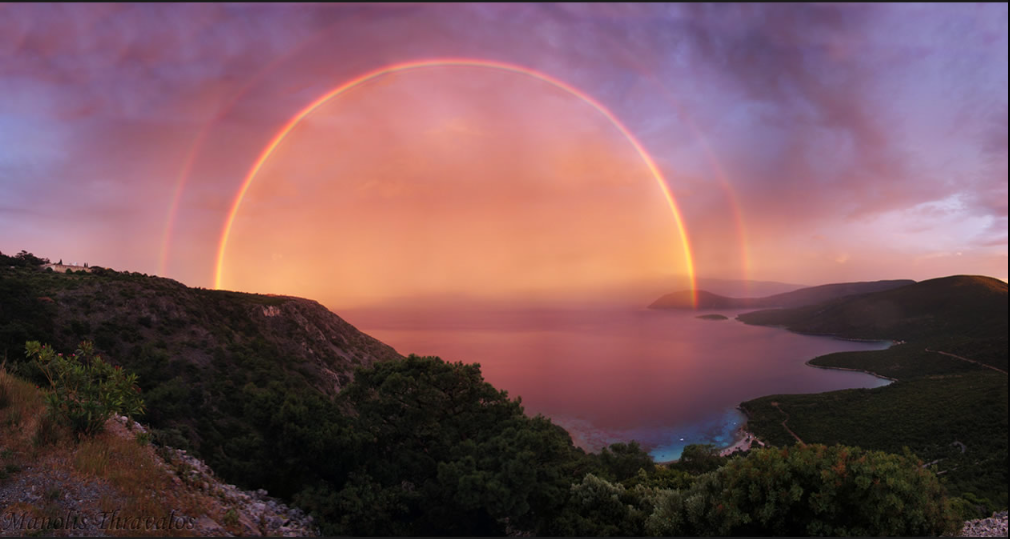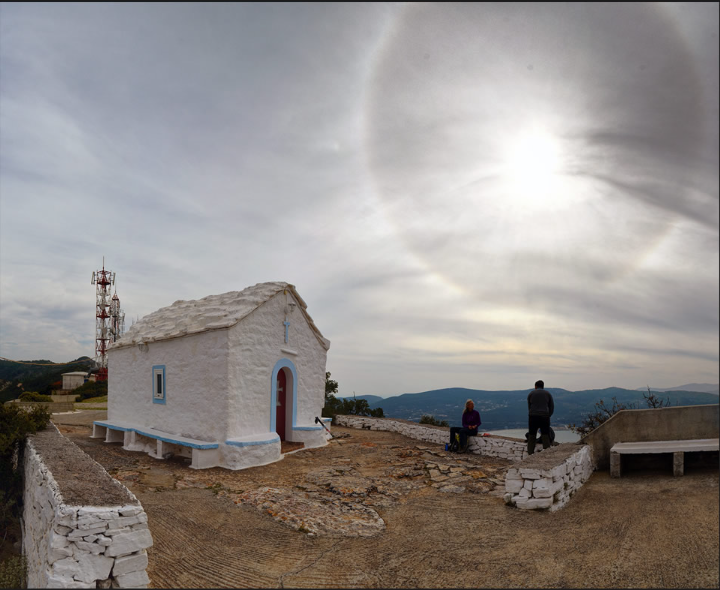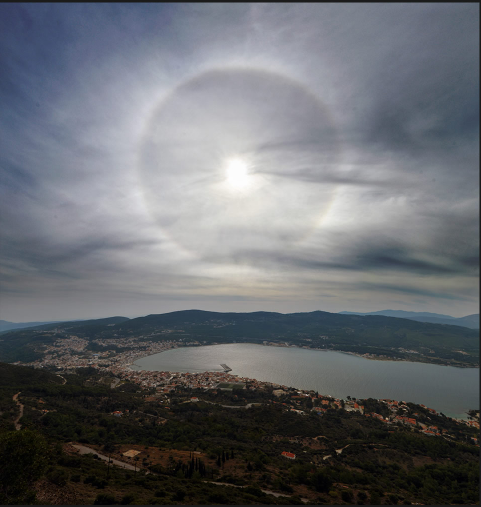Sky Optics, Samos, Greece - OPOD
Sky Optics, Samos, Greece - Exploring the Phenomena of Atmospheric Optics
Samos, a picturesque Greek island located in the eastern Aegean Sea, not only boasts stunning landscapes and a rich history but also offers captivating displays of atmospheric optics. With its close proximity to the coast of Asia Minor, Samos has become a favored destination for those seeking to witness the enchanting dance of light in the sky. In this article, we will delve into the fascinating world of sky optics, exploring primary and secondary rainbows, 22° halos, and their appearance on this beautiful island.
Unveiling the Wonders of Samos
As we venture into the realm of atmospheric optics on Samos, it is essential to acknowledge the island's historical significance. Samos has been renowned throughout history as the birthplace of influential figures such as Pythagoras and Aristarchus. These ancient scholars made significant contributions to our understanding of the cosmos, paving the way for future astronomical discoveries.
Aristarchus, in particular, revolutionized astronomical thought by proposing the heliocentric hypothesis, suggesting that Earth revolves around a fixed sun. This groundbreaking idea challenged the prevailing belief in a geocentric universe, where Earth was considered the center of all celestial motion. Aristarchus speculated that the lack of observable stellar parallax indicated that the stars were immensely distant, potentially other suns. This realization expanded our perception of the universe from a small and confined space to an unimaginably vast expanse.
However, despite Aristarchus' insights, his heliocentric model faced opposition and was overshadowed by the influential writings of Aristotle. It was not until Copernicus, over a millennium later, that heliocentrism regained its rightful place in scientific discourse. Nevertheless, Aristarchus' contributions to astronomy remain a testament to the pursuit of knowledge and the power of observation.
Primary and Secondary Rainbows: Nature's Colorful Display
On Samos, the spectacle of primary and secondary rainbows graces the skies, captivating observers with its vibrant hues. A primary rainbow forms when sunlight is refracted, or bent, as it enters a raindrop, then internally reflected off the drop's inner surface, and finally refracted again as it exits the drop. This complex interplay of refraction and reflection disperses the sunlight into its constituent colors, creating the iconic arc of colors that we associate with rainbows.
Secondary rainbows, on the other hand, are rarer but equally mesmerizing. They occur when sunlight undergoes a double internal reflection within the raindrop before exiting. This secondary reflection causes the colors of the rainbow to appear in reverse order compared to the primary rainbow. Additionally, secondary rainbows are fainter and have a larger radius than their primary counterparts.
22° Halos: Rings of Light in the Sky
Another enchanting atmospheric phenomenon frequently observed on Samos is the 22° halo. This captivating display manifests as a ring of light encircling the sun or moon at an angle of approximately 22 degrees. The halo is created by the refraction and reflection of sunlight or moonlight within hexagonal ice crystals suspended in the atmosphere. These crystals act as tiny prisms, bending and dispersing the light to form the halo.
The 22° halo often accompanies cirrus clouds, which consist of high-altitude ice crystals. These clouds serve as a canvas for the ethereal display, enhancing its visual impact. The halo's circular shape and its precise distance from the celestial body it surrounds make it an awe-inspiring sight for those fortunate enough to witness it.
Capturing the Beauty: Manolis Thravalos' Images
One individual who has masterfully captured the captivating sky optics of Samos is Manolis Thravalos. Through his lens, Thravalos has immortalized the beauty of primary and secondary rainbows as well as 22° halos, showcasing their intricacies and vibrant colors. His images provide a glimpse into the wonders of atmospheric optics, inviting viewers to marvel at the natural phenomena that grace the skies above Samos.
Thravalos' photographs not only serve as visual delights but also serve as a reminder of the importance of observation and appreciation of the natural world. Through his artistry, he encourages us to look up and take notice of the enchanting displays that occur daily above our heads.
Conclusion: Exploring the Skies of Samos
Samos, with its rich history and breathtaking landscapes, offers more than meets the eye. The island's skies come alive with a symphony of colors and light, showcasing primary and secondary rainbows and 22° halos. These atmospheric optics phenomena, rooted in the principles of refraction, reflection, and dispersion, remind us of the wonders of nature and the endless mysteries that surround us.
As we gaze upon the skies of Samos, we are transported to a realm where science and beauty intertwine. The legacy of Aristarchus and the artistry of photographers like Manolis Thravalos inspire us to embrace curiosity, observation, and the pursuit of knowledge. So, next time you find yourself on this enchanting Greek island, remember to cast your eyes upward and immerse yourself in the captivating world of sky optics.

Samos Optics ~ Primary and secondary rainbows and (below) 22° halos sighted by Manolis Thravalos (more images) on the Greek island of Samos. Images ©Manolis Thravalos.

Samos, in the eastern Aegean and only a mile from the coast of Asia Minor is famous for its wines and has a long history.
It was the birthplace of Pythagoras (c570 – c495 BC) and Aristarchus (c310 – c230 BC).
Aristarchus first advanced the heliocentric hypothesis that Earth revolves around a fixed sun. Previous ideas of an earth centred Universe had the stars attached to a relatively close sphere. With a moving earth they would appear to oscillate back and forth (parallax) each year. Aristarchus suspected that the stars showed no parallax because they were far more distant. Perhaps other suns. The previously small Universe had become immense.
Failure to detect stellar parallax and other issues remained objections. Ptolemy (c100 – 170 AD) reverted to an earth centred Universe. That, combined with the weight of Aristotle's writings, led to geocentrism again becoming the accepted teaching.
Copernicus, who was aware of the work of Aristarchus, finally restored heliocentrism 1300 years later.

Note: this article has been automatically converted from the old site and may not appear as intended. You can find the original article here.
Reference Atmospheric Optics
If you use any of the definitions, information, or data presented on Atmospheric Optics, please copy the link or reference below to properly credit us as the reference source. Thank you!
-
<a href="https://atoptics.co.uk/blog/sky-optics-samos-greece-opod/">Sky Optics, Samos, Greece - OPOD</a>
-
"Sky Optics, Samos, Greece - OPOD". Atmospheric Optics. Accessed on April 20, 2024. https://atoptics.co.uk/blog/sky-optics-samos-greece-opod/.
-
"Sky Optics, Samos, Greece - OPOD". Atmospheric Optics, https://atoptics.co.uk/blog/sky-optics-samos-greece-opod/. Accessed 20 April, 2024
-
Sky Optics, Samos, Greece - OPOD. Atmospheric Optics. Retrieved from https://atoptics.co.uk/blog/sky-optics-samos-greece-opod/.